Schroth DC Blog
Information to help treat scoliosis. Read for articles about the Schroth Method and how it can help stop curve progression and eliminate pain.
Pregnancy and Scoliosis: What You Should Know Before, During, and After
Pregnancy and Scoliosis. What you should know before, during, and after.
Tapped Out and All In: My Humbling Start in Brazilian Jiu Jitsu
Tapped out, showed up, leveled up. This is what BJJ taught me about movement, failure, and being fully present.
A Life Resurrected via the Schroth Method (and the McKenzie Method): Cathy’s Story
In fall 2022, my mom’s cousin Cathy—normally active and upbeat, called in distress after being sidelined by severe back pain and a slew of spinal diagnoses. That call led her to start Schroth-based physical therapy with us, beginning a healing, life-changing journey.
SchrothDC Has an App! Introducing ScoliFocus
ScoliFocus: Our new mobile app designed to support those living with scoliosis. Explore tailored workouts, dive into expert-backed information, and get to know the tools we're building to help you move, learn, and thrive.
Replicating the LIFTMOR Trial for Osteopenia and Osteoporosis
For years, my husband Eric insisted weightlifting was beneficial, but I dismissed it…until I attended a Bone Health symposium and learned that lifting heavy weights is key to preventing bone loss. Humbled, I admitted he was right and began my commitment to an eight-month LIFTMOR-inspired strength training experiment.
What Spine Type are You?
The Roussouly classification system categorizes sagittal spinal alignment into four types, which play a crucial role in both surgical decision-making and Schroth therapy for scoliosis. Understanding one's spine type allows for personalized exercise strategies that optimize posture, stability, and injury prevention.
Are your Back Muscles Getting Infiltrated with Fat?
Fatty infiltration of back muscles, especially in scoliosis patients, is linked to sedentary lifestyles and can be reversed with exercise. The Schroth method, focusing on spinal muscle strengthening, helps prevent and treat this issue. Encouraging physical activity is key to maintaining spinal health and preventing atrophy.
The Magical Power of Sound Bath Meditation
Caroline Campesi shares how Sound Bath Meditation helped her overcome emotional struggles, challenging her initial skepticism. She reflects on the healing power of sound and explores blending Eastern mindfulness with Western mental health practices, encouraging openness to unconventional paths to wellness.
My On Again/Off Again Relationship With Running…. And Why High Impact Exercise is Imperative for Our Bones
Caroline Campesi shares her journey from a party-focused undergrad to a driven PT student who started running to fit in. After a hiatus, she rediscovered running as a tool for improving bone health, managing stress, and setting an example for her children.
Botox and Scoliosis
Looking for more non-operative options to treat your child’s scoliosis? Enter Botulinum Toxin, aka, Botox, Hollywood’s favorite neurotoxin.
We are BoneFit™ Certified! (Exercise for Osteoporosis)
“BoneFit™ is an evidence-informed exercise training workshop, designed for healthcare professionals and exercise specialists. It provides instruction on the most appropriate, safe and effective methods to prescribe and progress exercise for individuals with low bone density and minimize their risk of falls and fractures.
“Listen to your patient; they are telling you the diagnosis”
I stumbled upon this quote early on in my physical therapy career, possibly even while I was still a physical therapy student, tucked into our curriculum by one of our wise professors. It has always stuck with me.
The Scoliotic Prominence and Muscle Length-Tension Relationship
Patients, and sometimes personal trainers and general physical therapists, observe, feel, and miscategorize what is called the prominence in scoliosis lingo.
Active Versus Passive Scoliosis Treatments
Devices like inversion tables have flooded the market in recent years as the U.S.'s appetite for consumerism and quick fixes has soared. We think it’s important to address them as a unit to help you all distinguish between passive and active treatments for scoliosis.
Life After Scoliosis Surgery
Spinal surgery can be scary, but life after spinal surgery for scoliosis doesn’t have to be. In fact, we hope that life after scoliosis surgery (for those who need it) is actually better.
Exercise Is Always (part of) the Answer
Exercise is always (at least part of) the answer in treating disease, be it arthritis, asthma, anxiety, diabetes, cancer, osteoporosis, back pain, or scoliosis. We, as physical therapists, consider ourselves the exercise specialists.
Torso Re-Shaping: Adult Edition
When we work with adults who are profoundly “correcting” their posture and re-shaping their torsos we are metaphorically jumping up and down with joy. Because, like so often happens in medicine, even if the research isn’t holding up, the anecdotal evidence can be powerful.
An Ounce of Prevention is Worth a Pound of Cure
As many of you know, we welcomed our third son, Cairo, about 8 weeks ago. As all babies do, they come out of the womb looking simultaneously perfect (to us parents) and a little funny to the rest of the world.
Medical Imaging Relevant to Scoliosis Care
Today we’re talking imaging – medical imaging – breaking down what types of images we use for diagnosis and treatment of those with scoliosis and kyphosis.
Bone Health and Scoliosis
If you are one of the many kids, adolescents, or adults living with and managing scoliosis, the importance of the health and strength of your bones cannot be overstated – we need to talk people!
Decoding Out-Of-Network Insurance Benefits
As I find myself late in my third trimester of pregnancy, needing many more healthcare services than I typically would, I realize that so many of my healthcare providers are out-of-network with my health insurance.
Bertolotti Syndrome and Scoliosis
Who is Bertolotti and what they heck is the syndrome named after him? This is a question I found myself asking earlier this week, after spotting a large bony abnormality on a patient’s x-ray.
What is Adolescent Idiopathic Scoliosis?
Most of our teenage patients here at SchrothDC have been given the diagnosis of Adolescent Idiopathic Scoliosis (AIS). It’s fairly common: out of 100 kiddos, approximately 3 of them will be diagnosed with it.
Bracing for Adult Scoliosis
If you’re looking for an opportunity to “poke the bear”, look no further than asking an orthopedist specializing in spinal disorders what he or she thinks of adult bracing for scoliosis…doctors absolutely hate this.
Treating Adult Scoliosis with the Schroth Method
Adult scoliosis is surprisingly prevalent in our population. There are three types: Adult-onset, also known as De Novo Scoliosis, Progressing or Stable Adolescent Idiopathic Scoliosis, and Secondary Scoliosis.
Torso Re-Shaping
Ok, I know what you’re thinking…I’m going to try to sell you on some crazy contraption to the likes of the waist trainers that the Kardashians use and promote. Make some grandiose promises about body transformation that sound too good to be true…Not quite, although torso re-shaping can seem pretty magical.
Schroth Method for Kyphosis
So many of our patients walk into their first visit with us saying, “I’m here because I’ve seen those little old ladies hunched over their walkers, and I don’t want to be one of them.” The medical term for what they are referring to is kyphosis.
What is Spondylolisthesis?
There’s a good chance you’ve encountered this long, imposing word while attempting to read through your lumbar MRI report. These reports can be full of words that hold very little or no meaning to the average human. Today we will attempt to shed light on a common occurance in scoliosis, spondylolisthesis, or for short, listhesis.
Hacks for Schroth Physical Therapy at Home
If you google search “Schroth Physical Therapy”, you will likely see pictures of people doing exercises on these sleek wooden ladder-looking contraptions. They are called Swedish ladders, or stall bars. These ladders are handmade, sturdy, aesthetically-pleasing, perfect for doing Schroth Physical Therapy…
PSA for those with lumbar scoliosis: Stop tucking your tailbones
I’m stepping up on my soapbox today to discuss a commonly prescribed movement that is driving me nuts in the clinic. The posterior pelvic tilt, or “tucking of the tailbone”, has somehow become a panacea for all low back issues. People get this advice ALL. THE. TIME.
Foundations of The Schroth Method
Many of us humans move through life at breakneck speed. All of these obligations take up A LOT of headspace. We often miss the small details unfolding around us. How does this tie into the Schroth Method? What I’m describing above is called awareness. (The popular buzzword for this is Mindfulness.) The Schroth Method requires a great deal of awareness; more specifically, it requires a great deal of body awareness.
Bracing for Scoliosis 101
So your kid was just recently diagnosed with scoliosis. Where do you go from here? Are they eligible for a brace? Will it be a nighttime-only brace or a full-time (21 hours/day) brace? Will it prevent them from having to have surgery? Navigating the world of scoliosis bracing can be daunting. Consider this your instruction manual.
Breathing: A Schroth Manifesto
Can you imagine being responsible for remembering to breathe 22,000 times per day? While we slumber, or while our brains are busy with another task – working, child-rearing, solving the problems of the world – our brainstem keeps our respiration going so that we stay oxygenized and alive.
The Vestibular System and Scoliosis
How is it possible to not realize that you are leaning to the left, that your weight is mostly on your left foot when you’re standing, or that your neck is tilted to one side? Answer: That big old adaptable brain of ours. Specifically, the vestibular system.
Hypermobility and Scoliosis
How many of us have envied those who are flexible, or have marveled at the amazing feats of gymnasts, ice skaters, yogis, and Cirque du Soleil performers? As a culture, we are entranced by flexibility; the beauty, the gracefulness, the perceived greatness of being flexible.
The Core and Scoliosis
I often hear patients lament about their lack of core strength, and attribute this to “not doing enough crunches”. Why is a crunch the first exercise we think of when we think of the core? There are many options for core exercises that avoid the crunch-like motion.
The Hip Flexors
Tight hip flexors can lead to Lower Crossed Syndrome, a common contributor to low back pain. Find out why this is often overlooked in medical settings, as well as how to assess and treat this common condition.
Lengthen your spine, lengthen your life
Taking care of your spine is so important. The spine serves as a relay-station for the limbs. It’s designed for mobility and stability. And at the end of the day, lengthening your spine can actually lengthen your life. Hear me out.
Why We Specialize in Scoliosis Treatment
Many patients ask me “How did you get into scoliosis treatment?”, usually followed by, “Do you have scoliosis?” Surprisingly to most, I do not have scoliosis. I like to say that scoliosis found me; not vice versa.
Welcome to Schroth DC!
We look forward to sharing information about the Schroth Method with you to help lengthen your spine and your life. We love seeing you live your best lives, regardless of your diagnosis. Cheers to a new year and the birth of Schroth DC!








































